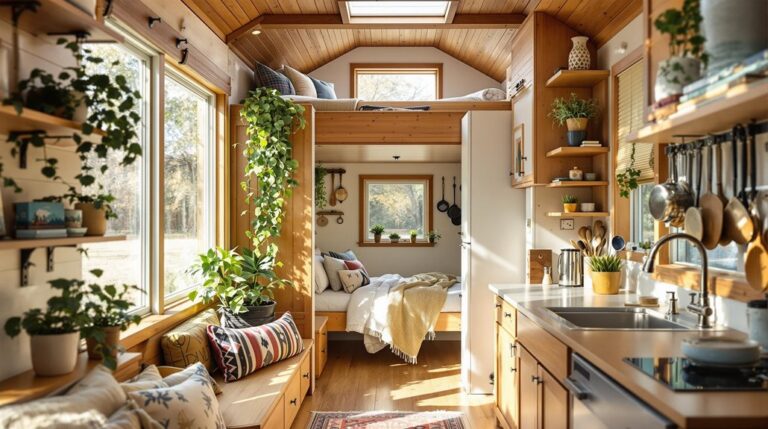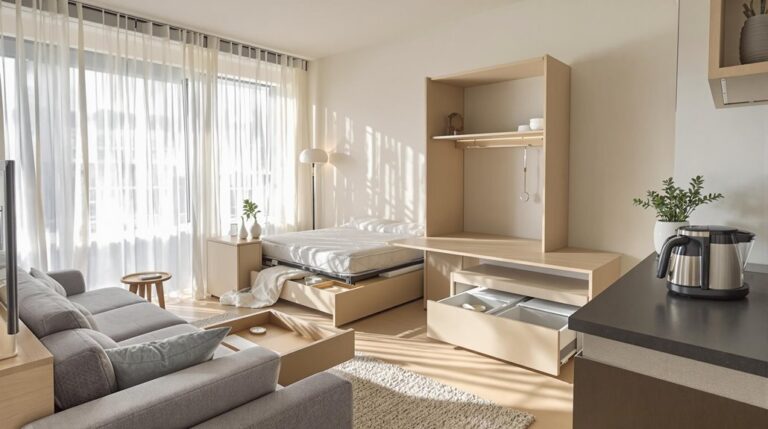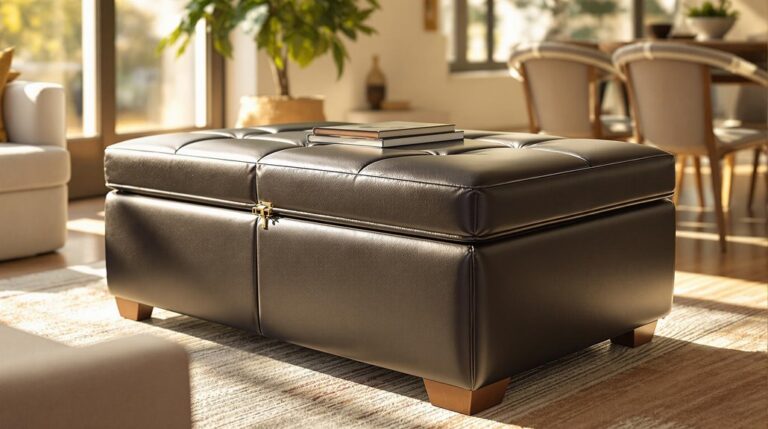Small-space living represents a deliberate shift away from excessive consumption and toward intentional minimalism. Modern enthusiasts of compact living discover that limitations in square footage often lead to expanded freedom in other aspects of life. With less physical clutter comes reduced mental clutter, creating room for experiences rather than possessions. The challenge lies not in fitting belongings into tight quarters, but in reimagining what belongings truly matter.
Key Takeaways
- Declutter regularly to reduce stress and create a calm, organized environment that enhances mental clarity and focus.
- Invest in multi-functional furniture like storage ottomans or convertible tables to maximize space without sacrificing comfort.
- Create distinct functional zones within your space using visual dividers to support multiple activities without feeling cramped.
- Prioritize items that serve multiple purposes or bring genuine joy to avoid accumulating unnecessary possessions.
- Utilize vertical storage solutions and wall-mounted options to free up floor space while maintaining a clean aesthetic.
The Psychology Behind Minimalist Small-Space Living
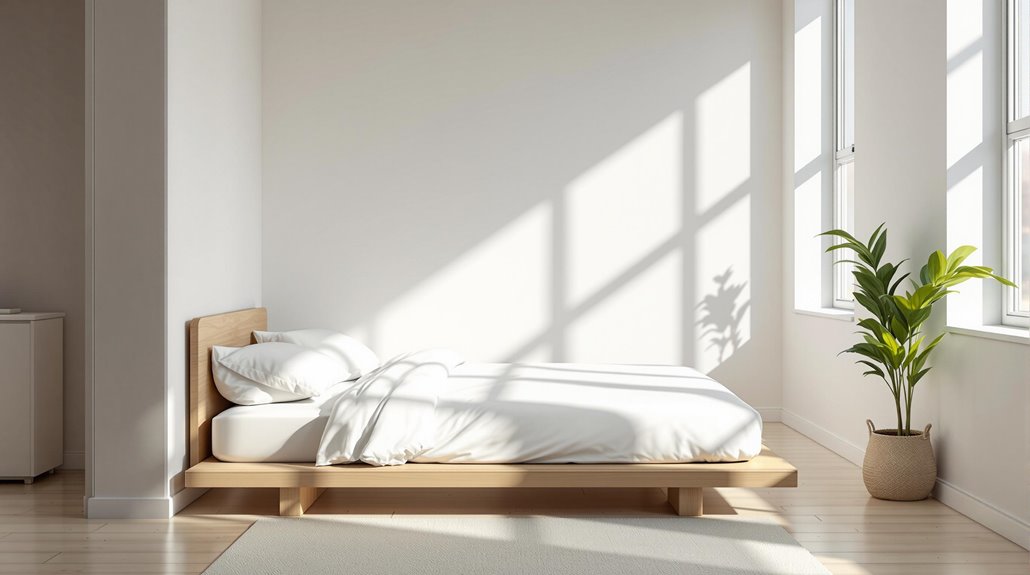
Serenity permeates the lives of those who embrace minimalist small-space living, creating profound psychological benefits that extend far beyond aesthetics.
Studies indicate that clutter-free environments markedly reduce cortisol levels, promoting emotional fulfillment and enhanced mental clarity. Those who downsize report experiencing less decision fatigue, allowing their minds to focus on priorities rather than possessions.
Living with less calms the mind, freeing our attention for what truly matters beyond material possessions.
This psychological freedom manifests in improved sleep quality, more efficient problem-solving, and deeper connections with core values.
By removing material distractions, individuals develop an intentional living mindset that prioritizes experiences and relationships over accumulation.
Small-space minimalists consistently report higher levels of joy and calmness, having freed themselves from constant consumption desires.
The simplified environment creates cognitive clarity that supports both productivity and personal growth, ultimately fostering a more meaningful existence.
Design Strategies for Maximizing Tiny Living Areas
When designing for minimal square footage, clever organization becomes essential for those embracing tiny living environments. Effective space planning begins with multifunctional furniture selections like sofa beds and storage ottomans that serve dual purposes while optimizing both vertical and horizontal dimensions.
Strategic furniture arrangement utilizing floor-to-ceiling shelving maximizes wall height potential, while large mirrors placed opposite windows amplify natural light, creating the illusion of expanded space.
Glass partitions, reflective surfaces, and light-colored finishes further enhance brightness without segmenting rooms. For maximum flexibility, modular designs allow reconfiguration according to changing needs—a feature 90% of renters prioritize.
Maintaining visual harmony through neutral color palettes and sleek furniture profiles prevents spaces from appearing cluttered. Hidden storage compartments in stairs, walls, and furniture provide practical solutions while preserving the clean aesthetic that defines successful minimalist small-space design.
Functional Zoning: Creating Purpose in Limited Square Footage
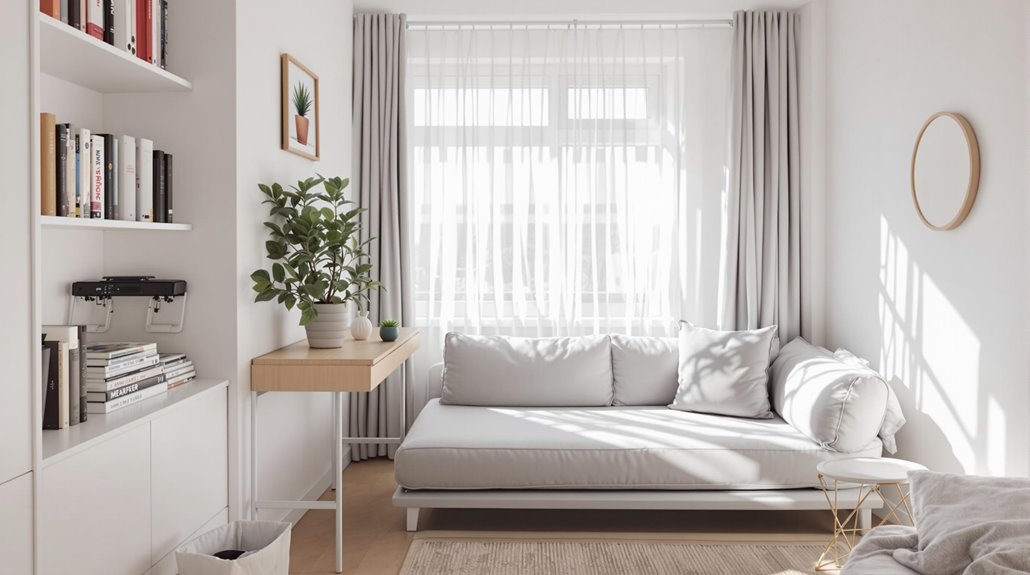
Functional zoning transforms limited square footage into purposeful living areas that support diverse activities without feeling cramped or disorganized. By establishing distinct zones through visual barriers like shelves or curtains, minimalists can create separation between living, working, and relaxation areas while maintaining an open feel.
Effective zoning techniques incorporate clear pathways with at least 30 inches of clearance, ensuring smooth movement throughout the space. Vertical storage solutions maximize wall space above five feet, while task-specific zones allocate footage based on immediate needs.
Spatial illusions further enhance these zones—strategically placed mirrors reflect light, creating depth, while lower-profile furniture expands perceived room dimensions. This approach delivers significant psychological benefits, including reduced clutter stress and improved focus through sensory partitioning, allowing minimalists to enjoy functionality without expensive renovations.
Multi-Purpose Solutions That Transform Your Space
Transforming limited living spaces requires ingenious multi-purpose solutions that adapt to changing needs throughout the day. Multi-functional furniture like wall beds with integrated storage maximizes vertical space while providing both sleeping areas and storage for belongings.
Space-saving designs such as transforming tables that convert from coffee tables to dining surfaces offer flexibility without sacrificing function.
Murphy-style installations conceal kitchenettes behind sliding panels, while pullout desks retract into walls when not in use. Bed frames featuring built-in drawers eliminate the need for additional storage furniture.
Movable room dividers define functional zones without permanent walls, allowing residents to reconfigure their space as needed. Coffee tables with hydraulic lifts serve dual purposes, raising to dining height when guests arrive.
These adaptable solutions maintain minimalist aesthetics while meeting diverse living requirements.
The Economic and Environmental Benefits of Living Small
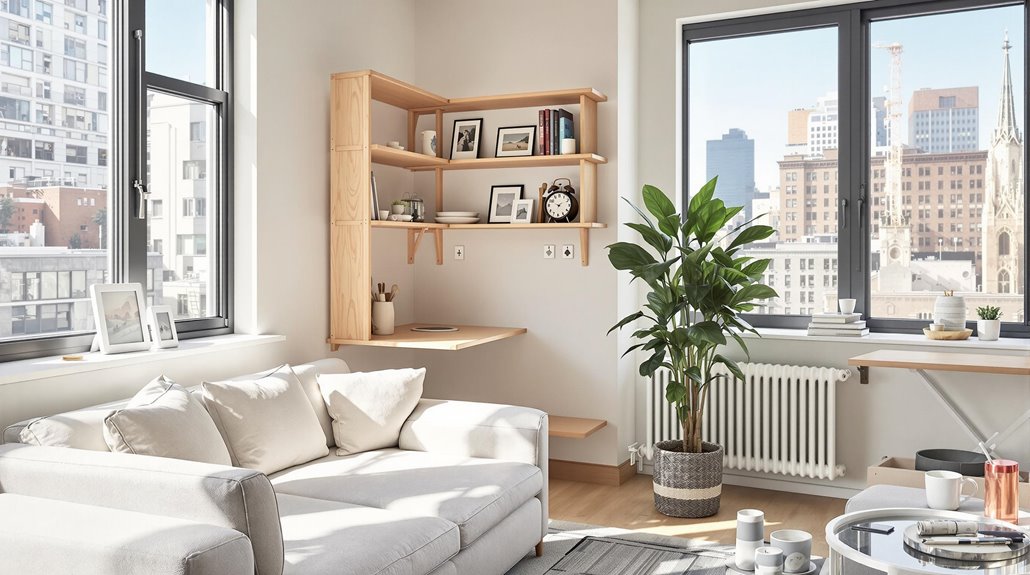
Living small extends beyond clever furniture solutions into meaningful economic and environmental advantages.
Compact homes reduce utility expenses considerably, with smaller spaces requiring less energy for heating and cooling. This efficiency translates to lower monthly bills and reduced carbon footprints.
Small spaces mean big savings on utilities while shrinking both monthly expenses and environmental impact.
The financial benefits continue as residents of small spaces often enjoy proximity to workplaces and amenities, cutting transportation costs while supporting local economies.
Urban density creates vibrant, walkable neighborhoods that minimize car dependency and foster community connections.
Construction of smaller dwellings demands fewer resources, allowing for greater use of sustainable materials while reducing overall environmental impact.
Additionally, compact living creates opportunities for affordable housing, enabling diverse populations to access the economic and cultural benefits of well-designed urban environments.
Navigating the Challenges of Minimalist Lifestyles
Why do many aspiring minimalists encounter significant obstacles on their journey toward simpler living? The path to minimalism often involves maneuvering through social stigma and cultural resistance from a consumption-oriented society.
Emotional attachment to possessions presents formidable barriers, particularly when items carry sentimental value or represent gifts from loved ones. Practical challenges emerge during decluttering processes, where decision fatigue can overwhelm even the most committed individuals.
Beyond initial hurdles, minimalists face over-optimization risks, including excessive analysis of purchasing decisions and unhealthy comparison with others’ minimalist practices. The pressure to perfect one’s minimal lifestyle can paradoxically create new stresses.
Additionally, maintaining simplicity in limited spaces requires constant vigilance against accumulation, especially when family members or friends continue traditional gift-giving patterns despite minimalist intentions.
Successfully addressing these challenges requires patience, clear boundaries, and systems that support sustainable simplicity.
Frequently Asked Questions
How Do Minimalists Handle Gift-Giving Occasions With Well-Meaning Family Members?
Minimalists navigate gift-giving occasions by practicing gracious gift acceptance while communicating thoughtful alternatives to well-meaning family members.
They employ strategies such as creating structured wish lists, suggesting experience-based presents, and expressing gratitude while gently introducing preferences.
Many establish clear boundaries through one-in-one-out policies, designated storage limitations, and transparent regifting practices.
What Small-Space Organizational Systems Work Best for Families With Children?
Families with children benefit from multi-functional storage systems that incorporate clear toy storage solutions and consistent family routines.
Vertical shelving maximizes space while keeping items accessible, while labeled bins help categorize belongings.
Implementing scheduled decluttering sessions and daily “5-minute tidy” practices teaches children responsibility.
Mobile storage carts adapt to various activities, and rotation systems for toys maintain stimulation without overwhelming limited spaces.
These approaches foster organization while accommodating children’s changing needs.
How Can Pet Owners Maintain Minimalism Despite Necessary Animal Supplies?
Pet owners can maintain minimalism through strategic pet supply storage and minimalist pet accessories.
Utilizing vertical space with wall-mounted hooks for leashes and designated zones prevents clutter spread. Multi-functional items, like beds with built-in storage, maximize space efficiency.
Adopting a “one in, one out” policy maintains inventory balance. Investing in durable, eco-friendly materials reduces waste, while rotating toys keeps pets engaged without accumulating excess items.
Can Minimalist Small-Space Living Accommodate Collecting Hobbies or Memorabilia?
Collectors living in compact spaces can thrive by implementing intentional collection strategies that focus on quality over quantity.
Limited memorabilia can be preserved through sentimental storage solutions like shadow boxes or digital archives.
Rotating displays maintain visual freshness while vertical storage maximizes available space.
Success requires regular evaluation of items’ significance, thoughtful organization systems, and creating designated zones that maintain balance between personal treasures and functional living areas.
What Digital Solutions Help Manage Paperwork in Tiny Minimalist Homes?
Digital filing systems like Evernote and mobile scanner apps transform paperwork management by converting physical documents into searchable digital formats.
Cloud storage solutions, including Google Drive and Dropbox, provide secure access to important documents from any device while eliminating physical storage needs.
These tools, paired with automated bill payments and document retention strategies, create an efficient paperless workflow that maintains organization while reducing clutter—essential for those wanting to simplify their administrative responsibilities.
Bottom Line
Minimalist small-space living offers more than just efficiency—it provides a pathway to intentional living. By embracing strategic design, multifunctional solutions, and thoughtful organization, individuals can create environments that align with their values and enhance well-being. Though challenges exist, the financial, environmental, and psychological benefits make the journey worthwhile. Small spaces, when approached with creativity and purpose, become not limitations but gateways to a more meaningful existence.

